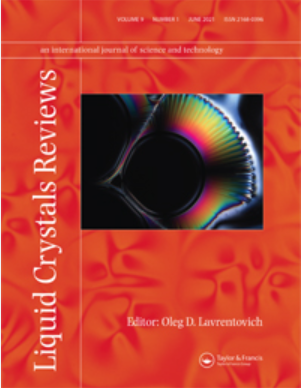向列型和胆甾醇型液晶中的莱曼效应
IF 4.2
3区 材料科学
Q2 CHEMISTRY, PHYSICAL
引用次数: 17
摘要
摘要莱曼效应是胆甾醇型液滴在温度梯度作用下的连续旋转。Otto Lehmann于1900年发现了这种效应,最近几位作者不仅在胆甾醇中,而且在指向矢场在液滴内部扭曲时的向列相中都重新观察到了这种效应。在大多数实验中,液滴与其各向同性液体共存,但当液滴分散在LC部分混溶的各向同性液体中时,也可以观察到莱曼效应。在简要介绍了莱曼效应的历史以及Leslie在1968年对其的首次解释之后,我们将回顾2008年以来在该主题上获得的主要实验结果。特别地,将描述温度梯度、液滴的大小、纹理及其相对于温度梯度的取向、限制效应、杂质和手性分子浓度的作用。还将特别强调流体动力学效应的研究,以回答旋转的是纹理还是液滴本身这一基本问题。然后,我们将回顾文献中提出的不同模型来解释莱曼效应。其中有两个直接基于Leslie解释的热机械模型(命名为TM1和TM2模型),一个是在热浪上旋转纹理“冲浪”的热力学模型(TM3模型),另一个是仅适用于液滴与其自身各向同性液体共存时的熔融生长模型(MG模型),以及基于Marangoni流存在的纯流体动力学模型(H模型)——目前仅在乳化胆固醇中得到证明。每个模型的优点和缺点将结合实验结果进行讨论。本文章由计算机程序翻译,如有差异,请以英文原文为准。
Lehmann effect in nematic and cholesteric liquid crystals: a review
ABSTRACT The Lehmann effect is the continuous rotation of cholesteric droplets subjected to a temperature gradient. Discovered by Otto Lehmann in 1900, this effect was re-observed recently by several authors not only in cholesterics but also in nematics when the director field is twisted inside the droplets. In most experiments, the droplets coexist with their isotropic liquid, but the Lehmann effect can also be observed when the droplets are dispersed in an isotropic liquid in which the LC is partly miscible. After a brief history on the Lehmann effect and its first explanation by Leslie in 1968, we will review the main experimental results obtained on this subject from 2008. In particular, the role of the temperature gradient, of the size of the droplets, of the textures and their orientation with respect to the temperature gradient, of the confinement effects, of the impurities and of the concentration of chiral molecules will be described. A special emphasis will also be placed on the research of hydrodynamic effects to answer the fundamental question of whether it is just the texture or the droplet itself that rotates. We will then review the different models proposed in the literature to explain the Lehmann effect. Among them are two thermomechanical models directly based on the Leslie explanation (named TM1 and TM2 models), a thermomechanical model of rotating texture ‘surfing’ on a heat wave (TM3 model), a model of melting-growth (MG model) that only applies when the droplets coexist with their own isotropic liquid, and a pure hydrodynamic model (H model) based on the existence of Marangoni flows – currently, only evidenced in emulsified cholesterics. The strengths and weaknesses of each model will be discussed in relation with the experimental results.
求助全文
通过发布文献求助,成功后即可免费获取论文全文。
去求助
来源期刊

Liquid Crystals Reviews
CHEMISTRY, PHYSICALCRYSTALLOGRAPHY&n-CRYSTALLOGRAPHY
CiteScore
7.60
自引率
5.90%
发文量
8
期刊介绍:
Liquid Crystals Reviews publishes review articles on all aspects of liquid crystal fundamentals and applied science, including experimental and theoretical studies of physical and chemical properties, molecular design and synthesis and engineering of liquid crystal devices. The Journal fosters cross-disciplinary exchange of ideas, encouraging authors to present material at a level accessible to specialists from other fields of science and engineering. Liquid Crystals Reviews provides the scientific community, in both academia and industry, with a publication of standing, guaranteed by the Editors and by the International Editorial Board who are active scientists in the worldwide liquid crystal community.
 求助内容:
求助内容: 应助结果提醒方式:
应助结果提醒方式:


